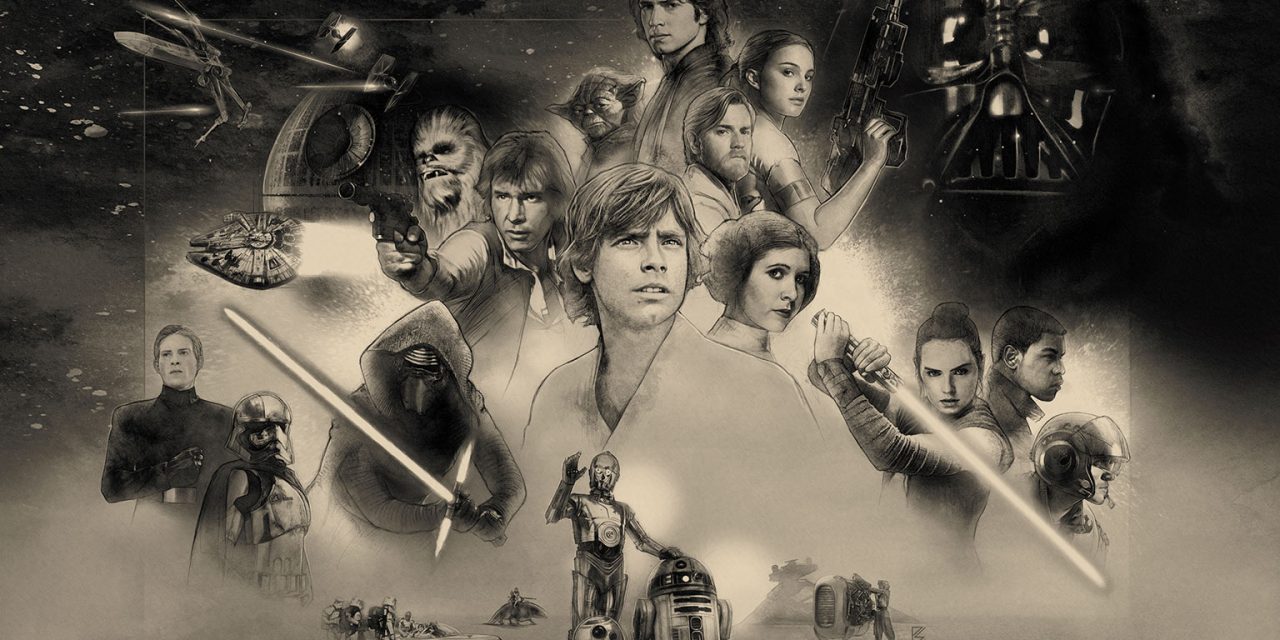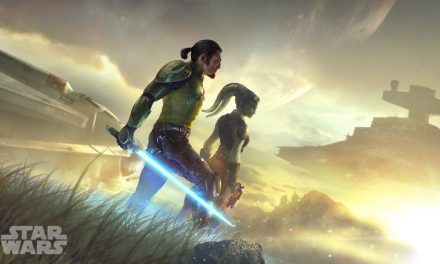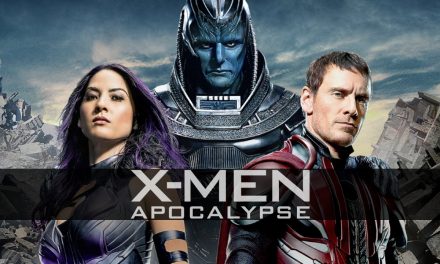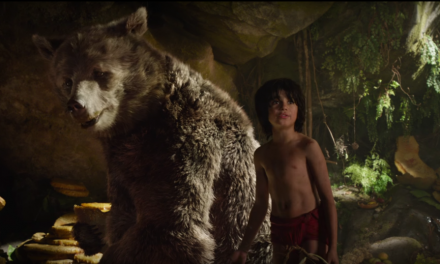The following article was written by Patreon donor, Mike Clark, in response to episode #98 of Echo Base about the proper viewing order of the Star Wars films for first-time viewers. It was published with his permission and remains as-is with minor edits and proofreading by Andrea Cardama.
I initially started writing this to respond to a letter that the Echo Base podcast received discussing the movie-viewing order in Star Wars (particularly for first timers). A lot of people have strong opinions when it comes to this topic. Most of these opinions are usually always centered around the same justification for watching the original trilogy (OT) first: to preserve the Darth Vader reveal to Luke, and to enthrall the audience watching the movies for the first time.
Interestingly, the letter received by the Echo Base podcast argued in favour of watching the movies in release order from three different perspectives: technical movie-making perspective, historical perspective, and an evolutionary perspective. These perspectives were different from the usual arguments, but I can see why they might make sense.
Before diving further into this discussion and exploring the letter, I wanted to impose two questions for first-time viewers:
Are you watching Star Wars only for “film school”; to learn about the genre, that specific style of movie making, the evolution of special effects, a generational look at how movies have changed over the years, ect.?
OR
Are you watching these movies to be engaged and invested in a complete storyline narrative?
I decided to further explore these ideas and make a case for why watching the Star Wars movies in chronological order makes the most sense for first-timers. This position is probably not the most common or popular amongst vocal Star Wars fans, but I think it is time to make a case for change.
For the remainder of my article it is of utmost importance to understand the context when answering the question of why the Star Wars movies should be watched chronologically.
In a “film school” context, it is obvious that watching the movies as they were produced and released is the best way to study them. This makes the most sense if the goal is to examine how the development of movie-making has evolved, particularly within the Star Wars franchise. In this context, the Star Wars storyline is not the focal point, it is not about the story experience that the fans have been debating, but about the technical and esthetics aspects of the films. It is about their development as a primer/history lesson for film study. Case closed.
The real issue of debate, when deciding viewing order, has everything to do with the context of the story that should be presented to first time viewers: Should this be a version of the story that was revealed to original fans who saw the movies as they came out? Or should this be a new version of the story, which no one before 2005 had the opportunity to see, as the chronological saga (before that point) was still incomplete?
I want to focus on the word ‘saga’ for a second. This itself refers to chapter stories, or pieces to a much larger narrative, an overall legend, myth, or storyline. Repeat this understanding in your heads; this is our Star Wars saga and it continues to grow and expand.
Star Wars has become larger than its original roots, and for those of us that experienced Star Wars before 1999, and the start of the prequels, we hold the original movies in high reverence and regard. Now, Star Wars is larger than the OT that some of us hold dear to our hearts. One could argue that before the Disney era, when it was just OT and prequel trilogy (PT), that the OT could still be the central focus or only focus for some. In the present day, the story has expanded beyond these two trilogies and to a new ST era that involves the anthology spin-off movies (Rogue One, Han Solo and likely many more which I predict will soon outnumber episodic movies in the future). This OT-centric view and context can no longer be maintained because of the expansion of the universe. The only reason so many wish to hold onto watching the OT first is for the nostalgic value.
We are now more than ever at a crossroads to see Star Wars in a new and greatly expanded way. We have an opportunity to change our views, to allow what we think of as Star Wars to expand, and for our original understanding to be re-centered as we move forward. Just like Yoda once said, “[we] must unlearn what [we] have learned.”
This is the overall crux of the argument when it comes to context. Some people believe that the Saga and all of Star Wars is about the OT (about Luke as the primary character and hero). They would say, before the Disney era, that the PT was just back story, but not the story. From this viewpoint, arguments for machete order or other chopped up viewing orders seem justified because they see the audience’s experience of the Star Wars story as being only from Luke’s perspective. For them, this is the focal point for the story and ultimately how audiences should experience the movies. In fact, some of these chopped up viewings remove movies deemed “undesirable” from the mix, (usually The Phantom Menace). I would say that George Lucas, despite starting at the middle of the story, always had a larger story that he wanted to tell. He didn’t have a crystal ball so he had to produce the movies the way he did, in case he never got the chance to do the full story he envisioned. Now that it is complete, he has indicated that it is one big saga, not just centered around one character or an individual perspective alone. With the creation of the ST, the point is made even clearer, strengthening the argument for chronological viewing of the now larger Star Wars story. Based on all of this, an OT/Luke-focused story that has him at the center of the universe no longer makes sense, nor does a chopped-up story narrative.
Let’s take this even further and really compare the different viewpoints without the nostalgic bias as much as we can. Let’s look at the intention and the setup of the narrative, by its creator, as one big linear storyline. In the first-time viewing context that focuses on the story narrative (not a technical or academic perspective), the only argument to watch the movies in a release order is centered around keeping the Vader Reveal as a surprise for the viewer. This includes any chopped up/machete order, such as (IV,V,I,II,III,VI,VII) or (I,II,IV,V,III,VI,VII). The purpose of all these orders are to preserve the Vader Reveal and treat the PT story as “flashbacks”, or background material. This is the focal point for those who saw the movies in the order in which they were released. For this group of viewers, the Vader Reveal is the most important and the most essential twist (much more important than any other twists set up in the chronological linear storyline). The other twists and surprises would be lost, but the Vader Reveal would be saved, because for THIS audience, the story is centered around Luke and the OT.
Having said this, choosing to watch the movies in chronological order is a way to argue that the Vader reveal is not the most important twist or reveal from the narrative story. In fact, an argument could be made that the original twist reveal for the audience may have never been George Lucas’ full intent. In this case, I will make an argument as to why the Vader Reveal is not as important as other reveals that are preserved when watching in chronological order, and will discuss the reasons why the PT is a better starting point and introduction into the Star Wars storyline.
As a caveat to those who love the impact of the Vader/Luke scenes of Empire, it can be argued that the impact is not lost with a chronological viewing and a modification of the Vader reveal. The reveal is actually enriched for the audience, something I believe was the intention once the six-movie saga was completed. The audience now knows something Luke does not, and waiting to find out what he will do and how he will react when it is revealed to him builds a different kind of suspense. This is especially true when watching Luke making some of the same mistakes his father, Anakin, was seen doing in the PT. The audience might worry about the potential downfall of Luke, much like Anakin, and might also be worried about what he will do when he learns the truth. The audience, with these concerns, ends up relating more to the concerns of Obi-Wan and Yoda in Empire. The new viewers see a buildup and are unsure how it might turn out, producing a sense of concern and maybe dread. This buildup continues until the conclusion of ROTJ, which I think works better as an overall story narrative.
Let’s look at additional reasons why the Vader Reveal is not as important as it once was:
The argument here is preserving the surprise for the audience who has no knowledge of Star Wars. First, I would say this seems fundamentally flawed, or a moot point, because the Vader Reveal is a common pop culture reference. Due to this, most people who aren’t kids are already somewhat familiar with it, or probably familiar enough, that the reveal will not be as shocking or a surprise as it was for first timers that saw Empire in 1980. I believe I make a reasonable assumption when I say that the bulk of people who have yet to see or hear of Star Wars in the future will be children. Star Wars is, and always will be, a story designed for kids, with darker adult themes and life lessons. This is not to say we won’t ever get more “adult-oriented” Star Wars content, or that there won’t be some adults who have never seen Star Wars, but the saga films and major movies put out by Disney and Lucasfilm will always be targeted towards kids and families.
Now, if contextually we are focused on adults instead of children, another point to consider is what movie to show them.
Is the purpose to explain Star Wars to an interested person so they can learn more?
What if I want to hook somebody into the larger Star Wars Universe beyond the films?
What movie should I show them?
While this is an interesting idea too, the context does matter in this argument. For an adult, it will be very subjective to decide which movie. I say just one movie singular because, depending on the adult watching it, they may not want to make the effort to watch all the movies therefore the viewing order you decide may be moot.
If you have a chance to show one of the movies to a kid, I would show them The Phantom Menace, which is the beginning of the chronological story. As a whole the story is designed for kids, so it makes sense that the first introduction would be very kid-friendly and easily accessible for them. Given the opportunity to show an adult one of the movies, I would probably go with The Force Awakens, and treat the rest of the saga as back story. This is because TFA is a modern-day movie, with certain modern-style editing, effects, etc. The problem with the one-movie choice is that the subjectivity exists because each of us has a bias about the movies. When someone asks us what movie they should watch first, each one of us is going to have a different opinion as to which movie they should view. It is always important to remember that the way we think of the movies isn’t necessarily how a first-timer will view them.
Which original viewer experience is the genuine one?
Many fans, including myself, did not see the movies in complete release order, because we weren’t old enough to even see ANH in theaters. I was 0 when ESB came out, and 3 when ROTJ came out. I saw ESB first and did not know the reveal, so I had the original impact that many describe with such fondness. I then saw ROTJ next, so for me ANH was always “backstory”.
Many people have a personal love for the OT in release order because those movies changed their lives, because they saw something on the silver screen they had never witnessed before, and that was why it was so captivating. Keep in mind most of the adults who were moved like that saw ANH in 1977 as a kid or teen. A person today, who has never seen Star Wars, is not going to be moved in the same ways, especially as a grown adult. The main reason is because they have likely seen other movies made in the past 40 years that have been shaped by what Lucas introduced in 1977: fast pacing and editing, getting dropped right into the action at the start, funny humor during serious moments, females taking the lead, laser fights, spaceship battles, and cutting edge special effects. Did I mention laser swords and alien space bars? Many modern sci-fi movies over the last 10-20 years have largely borrowed pieces from the Star Wars formula, so people watching ANH today will not feel the same way as many people did during their first SW experience (regardless of age).
Does the Vader Reveal have any other intrinsic value on its own?
If your focus is watching the movies and story through the perspective that this is Luke’s story, then yes it does have an intrinsic value on its own. This only makes sense if you are focused and centered on just the OT. I think we owe it to first-timers to drop our biases and our influences when telling them how to experience the story (no matter what order they watch the movies in).
For those who dislike the PT, my advice is for you not to speak negatively of it to first-time viewers, or be a part of the group think mob mentality. Let that new person watch the story from start to finish, and allow them to draw their own conclusions. I say this because many do not watch the PT since their Star Wars friend have told them that those movies sucked and weren’t important. This prevents people from ever watching the full story, or if they do, to be focused only on things from a negative perspective. Again, let them watch and make their own conclusions.
The first part of the argument is done! Now let’s flip the coin and make the case for why chronological viewing order is better for first-timers. What is preserved for the new audience member if they watch Star Wars in chronological order?
I would argue that there are much bigger twists, reveals, and saga plot points tied into Revenge Of The Sith, when watching the movies in chronological order. A first-time viewer would discover that Anakin’s close friend and confident, is in reality evil. Furthermore, the audience would be rooting for Anakin to fight the dark influences, but would be saddened/shocked to see him fail. It is the downfall of the hero. I still remember watching the way ROTS was set up, it is obvious that Anakin will fall into the hands of the dark side when Mace Windu confronts him. Anakin could have chosen at last second to do the right thing. I remember people telling me (and I did this same thing too), that they were rooting for Anakin not to attack Mace. The only reason it seemed obvious was because we knew what would happen next. The moment Anakin attacks Mace, everything changes, and this would be quite the shocker for first-time viewers.
Almost immediately after the biggest dramatic twist that occurs with Mace, the Jedi purge begins. The heroes the audience had been following for three movies suddenly get wiped out of existence. From both the character plot and the overall story narrative plot, there are many twists that are lost if you watch the movies in release order first, or even IV and V and then going back to the PT as flashbacks. The Fall of the Republic and Anakin Skywalker are major twists which I don’t think people, especially children, who have never seen or heard of Star Wars will see coming. Even the reveal of the Skywalker Twins at the end of ROTS, and the cybernetic birth of Darth Vader are surprising and exciting twists. Out of all of those moments, seeing the Chancellor revealed as the big bad is a much bigger twist in the grand scheme of things, and works cinematically in a much bigger way for the audience and the overall story. This reveal allows for the audience to go back and see the breadcrumbs left throughout the movies prior to the reveal.
Watching the PT first also gives a greater gravitas to the efforts made in ANH; the small size of the Rebellion and what they are truly trying to accomplish against the Republic/now Empire. Knowing the Clone Wars history and how the Separatists are now effectively the Rebels, also gives a different perspective of good vs. evil, and removes some of the black/whiteness of the OT. Watching the PT first also shows how menacing and powerful the Sith and the Dark Side of the Force truly are, so the stakes and risks are raised even more for Luke, Obi-Wan and Yoda by the time of the OT. The rhyme and rhythm of the PT vs. the OT, which was done intentionally by Lucas, flows better cinematically when watching the PT first. It allows the events of the OT to be shaped and the arcs of those characters to be introduced.
Another point to the argument would have to be why the PT is a better introduction to the Star Wars Universe versus starting with ANH. Overall, both ANH and TPM have exposition for the story, and both are designed to be standalone movies which don’t require further viewing beyond themselves. They both leave the viewer curious about the world they have witnessed, they leave an implied direction for characters to continue onward beyond the movie, and they wrap up their story nicely while still leaving the threat or “bad guy” around, much like old Saturday morning cartoon serials use to do all the time.
So why TPM vs. ANH?
TPM, and the PT as a whole, is meant to be much larger look into the world of Star Wars: how its worlds and people live and operate. It is a way to see how the Jedi, the Galactic Senate, and the Republic work and how they don’t always work. It sets up the stakes for everything to come later in both the OT and even the ST, regarding what they are fighting for, the morality issues, the differing viewpoints, etc. The OT and even the ST, from the looks of it, are taking much more micro looks into the Star Wars Universe, while the PT showed the much bigger view of that universe.
TPM is also a great introduction to the one thing that modern movie goers can see distinctively on a Star Wars movie that won’t be found in other sci-fi movies or summer blockbusters: Jedi and Lightsabers. These two things are important parts of Star Wars, and you get so much of it in the PT, compared to the other films later. Much like how ANH drops you right into the action but only a blaster fire fight, which plenty of people have seen now in other modern movies, TPM drops you right into the Jedi using the Force and Lightsabers to kick butt. To this day, I still love to watch the opening 10 minutes of TPM, and I think it’s a great way to start off the Star Wars movie saga with something that has a truly uniquely Star Wars feel. TPM is of course a stunning visual entry to introduce someone to Star Wars cinematically. It even has proper audience introductions for main characters like R2-D2 and C-3PO, who are likely to be the only characters featured in all the saga movies by conclusion of the ST.
Another good, contextual point (previously mentioned) is that most people who have never seen or heard of Star Wars, who would be viewing these movies for the first time would be younger people. TPM is the perfect first movie for them, it always captures a child’s excitement and imagination. Jar Jar is funny to them, the Jedi and Lightsabers are very cool, and the main protagonist is a 9-year-old, who wants to race cars, fly spaceships, and become an awesome Jedi. Kids can relate to young Anakin and his yearning for adventure and exploration, while trying to stay positive and upbeat. TPM is an exciting thrill ride and adventure story, with a beginning, middle, and an end, and as the movie progresses you look beyond the hero characters to realize how much bigger this universe really is.
TPM also introduces the political system to the movie goers, again this is macro level. The politics and governance story is necessary to show what people are fighting to restore later in the rest of the saga films. It gives context to the fighting, and also highlights the mastery of the Sith over manipulation which raises the stakes by the time ROTJ gets viewed, from both the character-driven story and the overall macro level story arc.
The Jedi are given a backstory of their place in the galaxy and how they currently work and operate. They also give a bit of knowledge about what the Force is, but not enough to answer everything, showing us the evolution of the Jedi to the more mystic focuses of the Force by ANH and ESB (the Obi-Wan and Yoda dialogue about the past and the Force having much more weight and meaning for the audience who has already seen the PT and the consequences of all the characters’ actions up to that point).
Watching in chronological order also reveals another narrative flow which is the story and focus on family, generations, and legacy. This was always a theme of importance to George Lucas, and is apparent in each trilogy of the main saga where there has been a focus on a new generation of heroes. It also literally focuses on the generations of Skywalkers. The PT is Anakin’s story, the OT is Luke’s story, and the ST is arguably both Rey and Ben’s/Kylo’s story. This shows a linage and a generational story complete with family legacies and lessons to be learned. You could also make the same argument regarding the villains of the trilogies as well and the faces of evil. This is again another reason to watch in chronological order, and I believe it is only going to be reinforced as the ST is completed.
This will have greater context as the Star Wars Universe continues to expand with other connected canon material. At some point the focus will not even be on the Skywalker lineage and that family story, but on bigger story themes across Star Wars as a whole. Eventually it won’t be limited to just a Luke-centered perspective, so why shoe horn the first time viewer into that forced perspective?
Now we come to what I like to call the “Expanded Viewing Order” as it focuses on the overall Star Wars story being told as the most important point (context especially for children and/or adults who are interested in diving into the larger universe of Star Wars). In my opinion, the expanded viewing order doesn’t focus on all the new canon materials such as the books and comics (but you could always include them too). It does, however, focus on the anthology films, and all the Animated Canon Series, Clone Wars and Rebels, as being part of the chronological story that the audience should be exposed to. In my case, I would be showing my kids TPM, then AOTC, followed by the Clone Wars for a while before we even get to ROTS (which is a heavier movie anyway). This builds up the characters of the Jedi: Obi-Wan, Yoda, Anakin, etc., and shows the political story arcs within the Clone Wars too. It keeps that macro focus while also building up the hero characters we are introduced to in the PT. This makes ROTS all that much more of a shocker, and really invests the audience even more into what happens after the PT. I would also throw in all the chronological anthology movies here too (Han Solo, Rogue One), if desired. You certainly could keep this to just a saga-movie-only focus, and just watch the episode movies in chronological order. That is perfectly fine if you want to focus on the main saga story. I would say if you add in the anthology movies, you should add in Clone Wars and Rebels too.
For the Rogue One debate, I don’t think it should be someone’s first introduction to Star Wars. I think if we are to include Rogue One, then all the other higher level canon material like the animated series should be included too. Otherwise the focus should just be on episodic saga story. Save Rogue One, Han Solo and the two animated series for later.
The Conclusion
In summary, if this is a “non-academic” first viewing focused primarily on the story experience and as an introduction to the Star Wars universe, then I say chronological viewing order makes more sense from both a thematic and cinematic story-telling perspective. The saga story is generational, and not just about Luke. The Vader Reveal, to the audience, is no longer the most important reveal in the grand scheme of the story. As the Star Wars saga gets larger, it becomes more clearly a story about different characters and themes through the different trilogies. We are moving beyond just the OT.
As far as opening the Star Wars Universe up to new viewers, especially the bulk of those being younger children, TPM is a better starting movie. If someone is really into the story, spend time with all the canon chronological material including Clone Wars, Rebels, and anthology movies, in chronological order.
If you are concerned an adult may only watch one Star Wars movie and that it may be their last if they don’t like it, then have them watch TFA over ANH (since you are not starting from the chronological beginning anyway), and then if they like it they can watch everything else as back story. This might be a more realistic recreation of people’s actual first viewing experiences of Star Wars similar to myself and others.
Remember that the way each of us first saw the movies and how those movies made us feel has a lot to do with the product of the times. It has to do with where we were in our lives when we first saw them, and our own biases towards the movies over the years (whether positive or negative). When introducing these movies to someone new, we should try our hardest not to let our own views and opinions color and influence what that new viewer will think. Give someone the proper context for the Star Wars movies and history, etc. and why they were made the way they were, without revealing any story elements, and then let them run right through the chronological story. Let’s give people the chance to see these movies in a way that wasn’t possible until the last decade. Let’s all unlearn what we have learned together, and embrace the change, because we can’t stop it. The Star Wars Universe is expanding and its future is as luminous as a Force Ghost.





